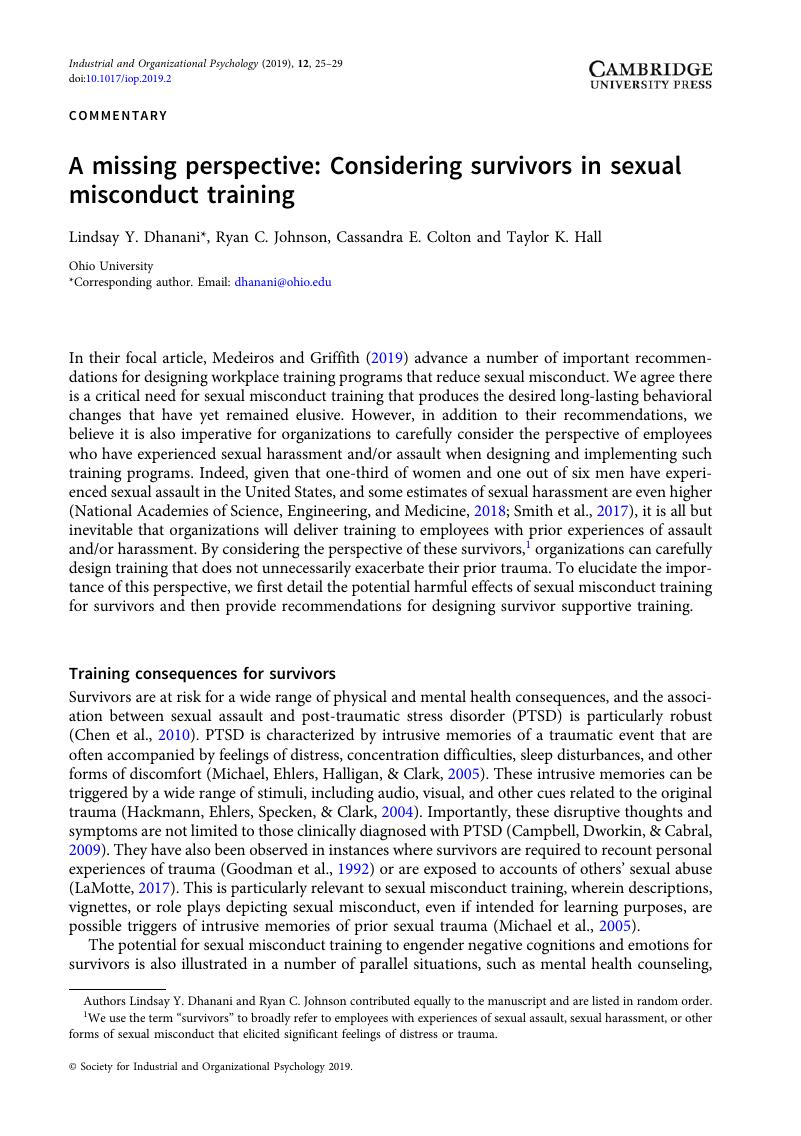No CrossRef data available.
Article contents
A missing perspective: Considering survivors in sexual misconduct training
Published online by Cambridge University Press: 15 May 2019
Abstract
An abstract is not available for this content so a preview has been provided. Please use the Get access link above for information on how to access this content.

- Type
- Commentaries
- Information
- Copyright
- © Society for Industrial and Organizational Psychology 2019
Footnotes
Authors Lindsay Y. Dhanani and Ryan C. Johnson contributed equally to the manuscript and are listed in random order.
References
Anderson, L. A., & Whiston, S. C. (2005). Sexual assault education programs: A meta-analytic examination of their effectiveness. Psychology of Women Quarterly, 29, 374–388.CrossRefGoogle Scholar
Brecklin, L. R., & Forde, D. R. (2001). A meta-analysis of rape education programs. Violence and Victims, 16, 303–321.CrossRefGoogle ScholarPubMed
Campbell, R., Dworkin, E., & Cabral, G. (2009). An ecological model of the impact of sexual assault on women’s mental health. Trauma, Violence, & Abuse, 10, 225–246.CrossRefGoogle ScholarPubMed
Chen, L. P., Murad, M. H., Paras, M. L., Colbenson, K. M., Sattler, A. L., Goranson, E. N., … L. J., Prokop (2010). Sexual abuse and lifetime diagnosis of psychiatric disorders: Systematic review and meta-analysis. Mayo Clinic Proceedings, 85(7), 618–629. doi: 10.4065/mcp.2009.0583
CrossRefGoogle ScholarPubMed
Fitzgerald, L. F., Drasgow, F., Hulin, C. L., Gelfand, M. J., & Magley, V. J. (1997). Antecedents and consequences of sexual harassment in organizations: A test of an integrated model. Journal of Applied Psychology, 82, 578–589.CrossRefGoogle ScholarPubMed
Friedman, M. J. (1996). PTSD diagnosis and treatment for mental health clinicians. Community Mental Health Journal, 32, 173–189.CrossRefGoogle ScholarPubMed
Goodman, G. S., Taub, E. P., Jones, D. P. H., England, P., Port, L. K., Rudy, L., & Prado, L. (1992). Testifying in criminal court: Emotional effects on child sexual assault victims. Monographs of the Society for Research in Child Development, 229, 1–159.Google Scholar
Hackmann, A., Ehlers, A., Speckens, A., & Clark, D. M. (2004). Characteristics and content of intrusive memories in PTSD and their changes with treatment. Journal of Traumatic Stress, 17, 231–240.CrossRefGoogle ScholarPubMed
Heppner, M. J., Humphrey, C. F., Hillenbrand-Gunn, T. L., & DeBord, K. A. (1995). The differential effects of rape prevention programming on attitudes, behavior, and knowledge. Journal of Counseling Psychology, 42, 508–518.CrossRefGoogle Scholar
Holland, K. J., Rabelo, V. C., & Cortina, L. (2016). See something, do something: Predicting sexual assault bystander intentions in the U.S. military. American Journal of Community Psychology, 58, 3–15.CrossRefGoogle ScholarPubMed
LaMotte, S. (2017). For some, #MeToo sexual assault stories trigger trauma not empowerment. CNN. Retrieved from https://www.cnn.com/2017/10/19/health/me-too-sexual-assault-stories-trigger-trauma/index.html
Google Scholar
Medeiros, K., & Griffith, J. (2019). #Ustoo: How I-O psychologists can extend the conversation on sexual harassment and sexual assault through workplace training. Industrial and Organizational Psychology Perspectives on Science and Practice, 12(1), 1–19.Google Scholar
Michael, T., Ehlers, A., Halligan, S. L., & Clark, D. M. (2005). Unwanted memories of assault: What intrusion characteristics are associated with PTSD? Behaviour Research and Therapy, 43, 613–628.CrossRefGoogle ScholarPubMed
National Academies of Sciences, Engineering, and Medicine. (2018). Sexual harassment of women: Climate, culture, and consequences in academic sciences, engineering, and medicine. Retrieved from http://sites.nationalacademies.org/shstudy/index.htm
Google Scholar
O’Leary-Kelly, A. M., Bowes-Sperry, L., Bates, C. A., & Lean, E. R. (2009). Sexual harassment at work: A decade (plus) of progress. Journal of Management, 35, 503–536.CrossRefGoogle Scholar
Orchowski, L. M., Untied, A. S., & Gidycz, C. A. (2013). Social reactions to disclosure of sexual victimization and adjustment among survivors of sexual assault. Journal of Interpersonal Violence, 28, 2005–2023.CrossRefGoogle ScholarPubMed
Raunick, C. B., Lindell, D. F., Morris, D. L., & Backman, T. (2015). Vicarious trauma among sexual assault nurse examiners. Journal of Forensic Nursing, 11, 123–128.CrossRefGoogle ScholarPubMed
Smith, S. G., Chen, J., Basile, K. C., Gilbert, L. K., Merrick, M. T., Patel, N., … Jain, A. (2017). The National Intimate Partner and Sexual Violence Survey (NISVS): 2010–2012 state report. Retrieved from https://www.cdc.gov/violenceprevention/pdf/NISVS-StateReportBook.pdf
Google Scholar
Society for Human Resource Management (SHRM). (2018, January 31). Harassment-free workplace series: A focus on sexual harassment. Retrieved from https://www.shrm.org/hr-today/trends-and-forecasting/research-and-surveys/Pages/Workplace-Sexual-Harassment.aspx
Google Scholar
Vijayasiri, G. (2008). Reporting sexual harassment: The importance of organizational culture and trust. Gender Issues, 25, 43–61.CrossRefGoogle Scholar




